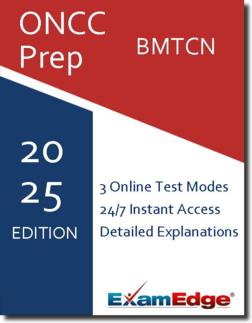ONCC BMTCN (BMTCN) Practice Tests & Test Prep by Exam Edge - Topics
Based on 29 Reviews
- Real Exam Simulation: Timed questions and matching content build comfort for your ONCC BMTCN test day.
- Instant, 24/7 Access: Web-based ONCC Blood and Marrow Transplant Certified Nurse practice exams with no software needed.
- Clear Explanations: Step-by-step answers and explanations for your ONCC exam to strengthen understanding.
- Boosted Confidence: Reduces anxiety and improves test-taking skills to ace your ONCC Blood and Marrow Transplant Certified Nurse (BMTCN).

Understanding the exact breakdown of the ONCC Blood and Marrow Transplant Certified Nurse test will help you know what to expect and how to most effectively prepare. The ONCC Blood and Marrow Transplant Certified Nurse has multiple-choice questions The exam will be broken down into the sections below:
| ONCC Blood and Marrow Transplant Certified Nurse Exam Blueprint | ||
|---|---|---|
| Domain Name | % | Number of Questions |
| Foundations of Transplant | 16% | 16 |
| Cellular Collection, Preparative Regimens, and Infusion | 16% | 16 |
| Early Post-Transplant Management and Education | 24% | 24 |
| Late Post-Transplant Management and Education | 22% | 22 |
| Quality of Life | 12% | 12 |
| Professional Performance | 10% | 10 |


